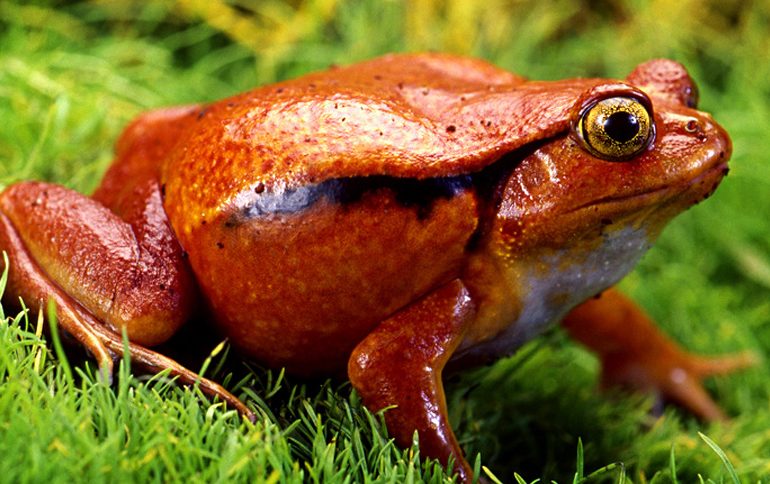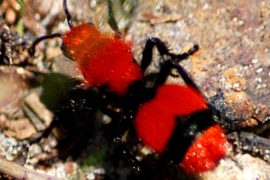A brightly colored frog
The tomato frog is a real eye-catcher in every terrarium. It clearly owes its name to its appearance, with which it attracts everyone’s attention. The tomato frog is bright red and orange on the back and has a rounded body shape, which is usually rather unusual for frogs. Because of the color and the round shape, it is reminiscent of a small tomato.
Another peculiarity of the tomato frog is that it cannot jump. This is due to its comparatively short legs. But he likes to climb and because of the webbed feet on his hind feet he can dig into the ground.
The tomato frog has its home on the island of Madagascar, which belongs to Africa. Here he stays mainly in the foliage of the rainforests. It is striking that the tomato frog only has a small distribution area. It occurs naturally only on the east coast of Madagascar. And here, too, there are limitations. It can be found from Antongli Bay to the area south of Tamatave.
Acquisition and maintenance
Although the tomato frog is not widespread in the wild and is used to tropical climates, it can be kept as a pet. However, there are many things to consider here. Before purchasing, one should obtain detailed information in order to guarantee species-appropriate keeping.
Where can you buy the tomato frog?
If you have decided to keep a tomato frog as a pet, you need to find a vendor nearby who has the small animals for sale. Since the tomato frog is a very special and rare species, it is sometimes not that easy.
There are some German zoos that house the frogs and make them available to their visitors to observe. But where do you get your own tomato frog from? Frogs are available for sale in a number of well stocked pet stores. There are also private breeders, where you absolutely have to pay attention to seriousness.
There is a reporting requirement
It is important to know when it comes to husbandry that many reptiles and amphibians are required to be reported. It’s the same with the tomato frog. Information on how to register is available from the Federal Agency for Nature Conservation.
As a rule, however, the registration is completed quickly – information on the species, age, size, sex and origin of the animal must be provided.
Requirements for the terrarium
If you decide to keep the tomato frog as a pet, large terrariums are well suited for keeping them. The frog should have enough space to forage for food, burrow around soil, and climb small branches or plants.
There are certain specifications as to the minimum size of the terrarium for different animal species. In the case of the tomato frog, these values are at least 60 by 40 cm. The height must be at least 30 cm.
In order to ensure species-appropriate keeping, the terrarium should be laid out with an earthy substrate. You can proceed generously and give the frog a few centimeters of depth to dig.
It is best to spread moss and some leaves on the earthy layer. The moss is important to maintain the humidity in the terrarium. The frogs like to take the leaves to crawl under.
The design of the terrarium
If you have laid out the floor well, you can design the living space for the tomato frog. The frogs like to have the opportunity to hide in small caves or niches. So you can lay out the terrarium with stones or curved tree bark.
A small house made of coconut shells, for example, is also suitable for furnishing. In addition, you should put some green plants in the terrarium to replicate the feeling of the rainforest as closely as possible. To give the frog the opportunity to climb, you can put thin branches or something similar in the terrarium.
It is also important in the terrarium that there is constant high humidity. However, waterlogging must not occur. UV lighting is not necessary.
Gender differences
The sex characteristics of male and female tomato frogs differ primarily in one category: their size. It is certainly known from other animal species that the males are usually larger.
With the tomato frog it is the other way around. While the females can grow up to 10 cm and weigh up to 230 grams, the males only reach a size of about 6 cm. There are no significant differences between the two sexes in terms of coloring and body shape.
The reproduction
The tomato frogs’ mating season is in March, since that is when the rainy season begins in the tropical rainforest. The frogs gather in ponds and at night the males give a loud concert. This attracts the females and mating occurs.
The female lays up to 1500 in the water and after two days the tadpoles hatch. After two to three months, the transformation into an adult frog begins.
Feed & Nutrition
Many different things are on the menu for tomato frogs. It is important to pay attention to a balanced diet and to provide the frog with a variety of nutrient sources.
Insects and worms should be the main items on the tomato frog’s diet. He also likes to eat snails and grasshoppers. In the wild, the frogs hunt, and also eat nestlings of birds and mice.
These do not necessarily have to be fed when kept at home. The insects and other animals can be fed in the live state. For this you can use tweezers, with which you can put small grasshoppers in the terrarium, for example.
Another important point in feeding is that you pay attention to the vitamin and calcium intake. This plays a major role in reptiles and amphibians in general.
Acclimatization and handling
If you have bought a tomato frog and want to put it in the terrarium, you have to be careful. This reduces stress and anxiety. Especially at the beginning you should give your new protégé a rest so that he can get used to his new surroundings.
If you notice at the beginning that the frog – not even in the evening – comes out of its hiding places, you should perhaps move the terrarium around again or deepen the substrate.
It should also be noted that the tomato frog should not be touched. The frog can quickly feel threatened. This not only leads to unnecessary stress, but it can also lead to a certain dangerous situation for the owner. If the frog feels threatened, it puffs up and squirts a poisonous secretion. This can cause irritation on human skin.
All in all, with care and a careful approach, the frog should get used to it quickly.
What do tomato frogs eat?
These frogs in the wild base their diet on invertebrates, whether they are larval insects or earthworms, and on occasion they can eat larger prey such as small rodents.
Where does the tomato frog live?
Its natural habitats include dry lowland forests, rivers, swamps, freshwater marshes, intermittent streams, arable land, plantations, rural gardens, urban areas, heavily degraded former forest, ponds, canals, and dikes.
How is the tomato frog?
The body is rounded and red or orange in color with some yellow spots around the mouth and on the side. The belly is light in color. The female is much larger than the male. It differs from the Sambava tomato frog in that it has a shorter and finer dark line running down its side.
What does a tomato frog need?
Two good substrates for a tomato frog terrarium are top soil or coconut fiber, like the Zoo Med Eco Earth Loose Coconut Fiber Reptile Substrate. Provide a depth of at least 2 inches because, as mentioned, tomato frogs are burrowers; they like to dig down into the substrate in order to ambush prey as it walks by.
What can a tomato frog eat?
Tomato frogs feed on insects, insect larvae and worms. Tomato frogs breed in freshwater pools. Females lay hundreds of black-and-white, sticky eggs on the surface of the water.
How often should you feed a tomato frog?
Young tomato frogs smaller than 2 inches in length should be fed daily (nightly, because is when they will be hunting) whatever they can consume in 24 hours, generally 3-4 crickets or the equivalent. Adult frogs can be fed 6-10 crickets every other day.
Can I hold my tomato frog?
Like most frogs, the tomato frog does not like being handled. Though it won’t harm your pet to transport them from one enclosure to another (such as to clean their cage), frequent handling can cause a great deal of stress for your pet.
Can I feed my tomato frog mealworms?
Being a short, stocky ground dweller, the Tomato Frog naturally feeds on worms, snails, burrowing insects, and the occasional small frog or rodent. In captivity, earthworms, mealworms, superworms, waxworms, tomato worms, crickets and the occasional pinky mouse are good candidates for a fairly well rounded diet.
How do you clean a tomato frog tank?
Soap and other chemicals on your hands will be absorbed by the frog, which can be harmful. Rinse your hands with water and leave them damp. Carefully place them into a small container and remove them from their enclosure so you can clean their terrarium.
Are tomato frogs easy to take care of?
Named both for their bright red color and their ability to “puff up” in self-defense, tomato frogs are unique and relatively easy to care for. Because of this, tomato frogs are one of the more popular amphibians to keep as pets.
How often should you clean a tomato frog tank?
Clean the substrate about twice a month to prevent bacteria build up. When cleaning the entire tank, use only hot water as the frog’s skin is very sensitive. If you move your tomato frog to a different container while you clean the tank, be very gentle and use only two fingers to pick up the frog.
How often do tomato frogs poop?
Adult frogs usually relieve themselves once or twice a week. However, adult frogs don’t actually need to poop that often; in fact, they could be able to go up to two weeks between the times they poop.
Do tomato frogs need heat?
Your frog’s terrarium should be warm — between 70 and 80 degrees Fahrenheit during the day and 65 F to 70 F at night. If necessary, use a heat bulb and/or a night-specific heat lamp for warmth. A thermometer at each end will help you monitor the temperature.
Do tomato frogs croak?
Communication: During the rainy season, males can be heard croaking from shallow pools of water, ditches or marshes as they try to call females with which to breed.
How do you set up a tomato frog tank?
How long do tomato frogs live?
The lifespan of the tomato frog can be from 6 to 8 years. When adult, the colors may vary from yellowish orange to deep red. Tomato frogs will reach sexual maturity in 9–14 months. Females are larger than males and can reach 4 inches in length.
How much room does a tomato frog need?
For a pair of adult tomato frogs, a 20 gallon long or an 18x18x12 front opening enclosure is sufficient. As this species is semi-fossorial, a good substrate that facilitates this behavior, such as coco fiber, is best.
Are tomato frogs noisy?
In the wild males are very vocal at night time. They use loud calls as a way to attract mates. Tomato frogs kept as pets will be largely inactive during the day. It is normal to find them burrowing and resting.





